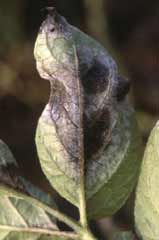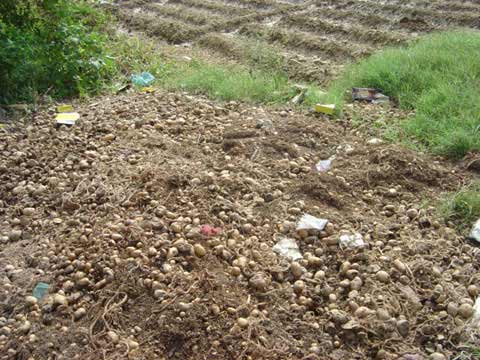Late blight caused by the fungus Phytophthora infestans is the most
important disease of potato that can result into crop failures in a short period if appropriate control
measures are not adopted. Losses in potato yield can
go as high as 80% in epidemic years. During past
years, epidemics of the disease have appeared in
1985-86, 1989-90, 1992-93, 1997-98, 2006-07 and
recently during 2007-08 season.
Distribution in State
Late
blight occurs frequently in the districts of
Hoshiarpur, Jalandhar, Nawan Shehar, Kapurthala, Ropar
and Amritsar. Hoshiarpur is generally considered to be
the hot spot for this disease. The disease is
generally observed first in certain pockets of
district Hoshiarpur like Sham Chaurasi, Mehtiana,
Phuglana and areas around Tanda and spreads further to
adjoining regions under favourable weather conditions.
In the districts like Ludhiana, Patiala, Fatehgarh Sahib, Moga and Sangrur, the disease is noticed in moderate
incidence and does not appear every year or develops
late in the season. South-western districts such as
Bathinda, Faridkot and Ferozepur mainly remain free
from the disease or its attack is observed very rarely
during prolonged epidemic years only. Based on
prevalence of the disease in different regions
recorded over the past years, a late blight map for
Punjab has been prepared. Normally, early sown crop,
planted in early September and harvested in
mid-November for table purpose, escapes attack of the
disease because of high temperature prevailing during
this period or may be affected slightly at the end
without causing any significant damage.
Potato Cropping
Period and Late Blight favourable Period
Symptoms of Late Blight
On leaves:
-
Small water-soaked spots develop at the tips, margins or
any other part of the leaf which enlarge to form
irregular dark brown lesions surrounded by a light green
halo.
-
During morning hours, a whitish cottony growth of the
fungus is visible around the dark brown lesions on the
under surface of the leaves especially when weather
remains sufficiently humid or when there is dew fall in
the morning hours.
-
If the weather turns dry, the lesions become necrotic
and dry up.
-
Under favourable weather conditions (low temperature,
high humidity due to intermittent winter rains) the
disease spreads rapidly and whole of the crop may be
killed within 10-14 days giving blighted appearance.

Potato Leaf
Showing late blight Symptoms |

Potato foliage
affected by late blight |

Sporulation of
P.infestans on lower leaf
surface |

Potato field
affected by late blight |
On Stem:
-
In case of infection originating from infected tubers,
elongated brown stripes develop on the stem from below
the ground level and encircle it.
-
The lesions also appear on the stem near the growing
point when the inoculum of the fungus comes from the
infected plants.
-
The infection can also start at nodes and extend both up
and down the stem and the plant topples down under congenial weather conditions.
-
The infected portions of the stem bear white fungal growth
especially visible in early morning hours but are not as
prominent as on
leaves.

Late blight symptoms on potato stem |
On Tubers
-
Infected tubers show irregular, shallow or sunken
reddish brown patches. Inside infected tissue is spongy
and rusty brown to varying depths. In sub-mountainous
areas, the lesions on tubers are locally called "Pathar
Dag". Later on, these lesions are often invaded by
secondary pathogens especially in wet soils or in
storage resulting into soft rot.
-
Smaller immature tubers are more prone to infection as
compared to the larger ones and rotting is more in heavy
wet soils.
-
Late blight does not spread from tuber to tuber in cold
stores.
-
Varieties with short stolons bearing tubers near to stem
are more liable to tuber infection as in case of variety
Kufri Chandramukhi.
Late blight symptoms on potato tubers
Late
blight on spring crop
In
spring crop, which is planted in January, sprouts are
attacked at very young stage as the inoculum of the
fungus is readily available from the already infected
main season crop. Under such conditions, young leaves
and stems near the growing points are infected by the
fungal spores called sporangia. Brown necrosis is
evident around growing points. Ultimately whole of the
young sprouts are killed causing almost complete loss in
the yield.

Young potato plant attacked by late blight |
Disease source, development and spread
-
The primary source of the disease is infected seed
tubers planted after cold storage.
-
Not all, but a few of the infected tubers give rise to
primary sporangial inoculum which further infects the
nearby plants creating a primary focus of infection in
the field.
-
Some of the infected tubers do not sprout or are soon
killed after sprouting giving patchy appearance in the
field.

Diseased tubers piled up near potato field
-
The heaps of culled infected potato seed piled near the
cold stores also serve as source of primary inoculum for
the adjoining fields.
-
In the district of Hoshiarpur and adjoining areas of
Nawan Shahar, the disease always appears early due to
presence of primary inoculum in the form of infected
tubers and favourable weather conditions such as high
relative humidity and low to moderate temperature.
For late sown or
spring crop or where successive crops are grown, the
previous infected crop often serve as the major source
of huge primary inoculum.
Disease cycle
-
The fungus over-summers as mycelium in the infected seed
potato kept in cold stores.
-
These tubers when planted in the next crop season (main
crop and subsequent ones) serve as the source of primary
inoculum.
-
When the plants emerge from such tubers, the fungus
invades a few of the growing sprouts and sporulates
(produce sporangia) under humid conditions. Further
spread of the disease takes place by these sporangia
through air or rain splashes.
-
Initiation of the disease generally takes about 3-7 days
before clearly visible symptoms develop. The fungus
produces white sporulation on the underside of the
leaves which is clearly visible in the early morning
hours.
-
These sporangia further infect new leaves and stems of
the nearby plants and this cycle continues after every
4-10 days depending upon the prevailing temperature and
humidity levels.
-
If the temperature is lower than 100 C,
disease development slows down and takes more time up to
12 days while at temperature of 16-180 C, it
takes only 4-5 days to complete one cycle.
-
Sporangia washed by rain or carried by irrigation water
cause infection on tubers in the soil.
-
Partially exposed tubers can easily become infected.
-
These infected tubers serve as the primary source of
inoculum for the next year’s crop.
Disease Cycle of Late Blight of Potato in Punjab
Races of Phytophthora infestans
Presently,
there are multigene complex races of P.infestans
on Potato in Punjab. Commonly occurring races in the State
are:
-
1.2.3.4.5.7.10.11
-
1.2.3.4.7.10.11
-
1.2.3.4.5.7.11
Sporangia of P. infestans